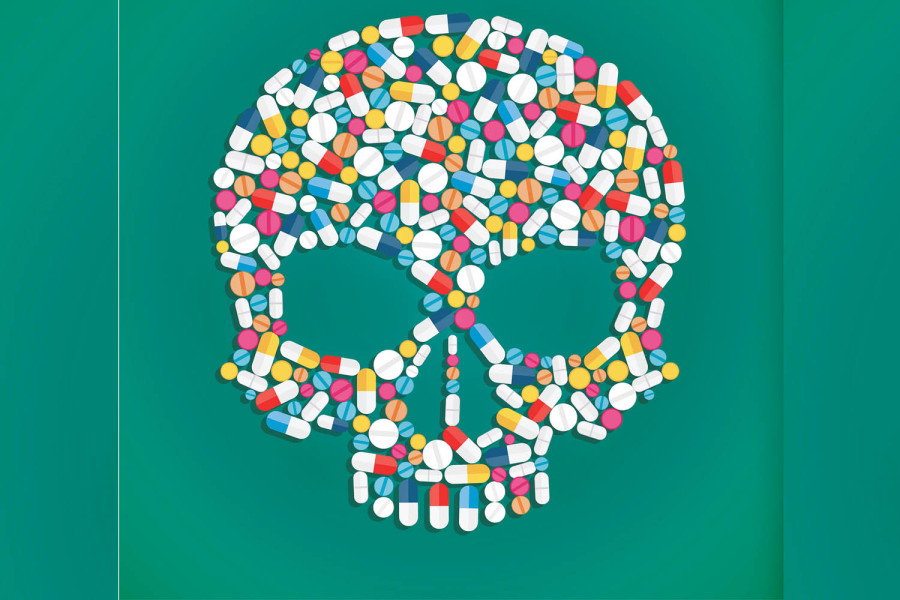Health
Most doctors in Nepal don’t prescribe antibiotics by generic name: Study
‘Pharmas pay doctors for prescribing their products, and many use only specific brands.’
Arjun Poudel
About 85 percent of the doctors in Nepal do not prescribe antibiotics to patients by their generic name, meaning that most of the antibiotics are being prescribed by their brand names, according to a new study carried out by the Nepal Health Research Council.
Nepal doesn’t have a mandatory policy that medicines, including antibiotics, should be prescribed by their generic names. However, the World Health Organisation recommends the same.
“Doctors get paid by pharmaceutical companies for prescribing their products, and many doctors only prescribe specific products of certain manufacturing companies, from which they get kickbacks,” an official at the Department of Drug Administration, the national drug regulator, said asking not to be named, as he is not authorised to speak to the media. "These practices are not hidden to anyone. Due to such practices, medicine becomes dearer and the patients have to pay the price, ultimately."
The report also shows how antibiotics are being prescribed in the country, which is a dangerous practice, according to experts.
As per the report, only 32 percent of the doctors and health workers have access to laboratories for antibiotic susceptibility testing. Among them, only 49 percent recommend antibiotic susceptibility testing before prescribing antibiotics. This means that only 16 percent of doctors recommend antibiotics after susceptibility testing.
"There is a significant reason for influencing rational prescriptions of antibiotics," the report stated.
Doctors say sensitivity to antibiotics must be known before the prescription, but very few doctors bother to understand their patient’s sensitivity to the drugs they prescribe.
According to experts, antibiotics must be prescribed on the basis of clinical diagnosis. They say the antibiotics do not work if the underlying infection is caused by a virus.
The study also shows that more than one-third—37.8 percent—of prescribed medicines were antibiotics, which is higher than the standard as given by the World Health Organisation.
The study shows about one-fourth (22 percent) of the outpatients did not consume a full course of antibiotics. Similarly, about 10 percent of the outpatients consume antibiotics as prophylaxis and eight percent of them consume double dose antibiotics for a quick recovery.
Around 22 percent of them save residual antibiotics for treating similar symptoms in future. Additionally, around 28 percent of the outpatients said that they buy antibiotics without doctors' or health worker’s prescriptions.
This shows that a significant number of patients do not have knowledge that the course of antibiotics must be completed and if they stop halfway, the same antibiotic may not work the next time.
Public health experts warn that antibiotics, which have saved millions of lives throughout the world, could soon become ineffective due to the high resistance rate caused by their irrational use.
A lot of Nepali patients countrywide have been affected by antimicrobial resistance due to their irrational use in the treatment of infections.
The report showed that 41 percent of the doctors and health workers had not heard of a national guideline for antibiotics prescriptions. Among the around 59 percent of those who had heard about the national guideline for antibiotics prescriptions, only 54 percent had access to it.
The over-the-counter dispensing of antibiotics by community pharmacies and the purchase of antibiotics without prescriptions by outpatients was identified.
In community pharmacies, the majority of the drug dispensers (43.4 percent) dispense antibiotics without a doctor's or health worker’s prescription, said the report.
Azithromycin (24.5 percent), Amoxicillin/Amoxyclav (20.5 percent), Cefixime (14.8 percent), Ciprofloxacin (14.1 percent), and Metronidazole (9 percent) were the most commonly dispensed antibiotics without prescriptions from doctors and health workers.
Similarly, the study showed, Oxytetracycline, Gentamicin, and Enrofloxacin were found to be the most commonly prescribed antibiotics for animals.
About 66 percent of the veterinary pharmacists do not keep an animal's record for dispensing antibiotics.
Around 70 percent of the farmers were found to be increasing the dose and frequency of antibiotics for a faster recovery.
The study identified the huge shortcomings in awareness and availability of national guidelines for prescribing antibiotics and infrastructures for recommending antibiotic susceptibility tests among both human and animal health professionals, despite the development of various policy documents and guidelines relating to antibiotics prescriptions.
"This study clearly depicts the need to develop and update the policy on antibiotics, dispensing along with clear demarcation of the qualifications for prescribers at all levels," said the report.
"The infrastructure for testing the susceptibility to antibiotics needs to be strengthened up to the local-level health facilities for ensuring rational use of antibiotics among both humans and the animals."
Since the patients were found not to consume a complete dose of antibiotics, the health professionals should counsel their patients effectively for completing the course of antibiotics, according to the report.
"Health education should be provided to all (including community people) on proper use of antibiotics through local health workers and volunteers," the report said. "Strict monitoring and regulations should be in place to prevent dispensing of antibiotics, especially prohibited (Colistin for animals) or reserve group of antibiotics, from the community pharmacies/vet pharmacies without prescriptions."




 8.12°C Kathmandu
8.12°C Kathmandu













%20(1).jpg&w=300&height=200)
